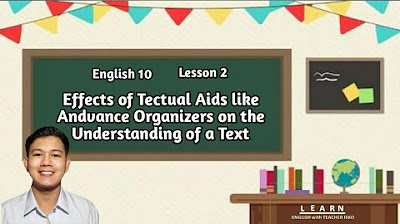INTERPRETING GRAPHICS IN EXPOSITORY TEXTS || English 8 || NEW NORMAL || QUARTER 2 - MELCs
Summary
TLDRThis video explains how to interpret graphics in expository texts, a topic designed to help students understand visual elements such as illustrations, photographs, and charts. It breaks down the process of analyzing images by identifying their core message and providing additional details. The video also guides viewers on how to interpret graphs, emphasizing the importance of following given instructions and extracting key data. Through examples, including a photo depicting poverty and a pie chart about farm animals, viewers learn to effectively interpret visual information and enhance their understanding of the content presented.
Takeaways
- 😀 A graphic is any visual representation such as an image, chart, or graph.
- 😀 Expository texts aim to explain, inform, and present facts on specific topics.
- 😀 Illustrations are drawings or sketches, while photographs are literal snapshots.
- 😀 To interpret a graphic, always look for the message it is conveying.
- 😀 A photograph can convey powerful messages, such as highlighting social issues like poverty.
- 😀 When interpreting a pie chart, identify the highest and lowest categories to understand the data.
- 😀 Interpreting a graph involves extracting key details and analyzing the information in context.
- 😀 Symbols used in graphics, such as a green earth in a head, can help convey deeper meanings, like environmental responsibility.
- 😀 When interpreting a graph with no specific instructions, consider explaining from the highest to lowest values or vice versa.
- 😀 Always look for the main concept in an image or photograph and add relevant details to enrich your interpretation.
- 😀 Good interpretation of graphics can lead to insightful essays or discussions on the themes presented in the visuals.
Q & A
What is a graphic in the context of expository text?
-A graphic is a visual representation, such as an image, illustration, graph, or chart, that helps convey the message or information in an expository text.
How is expository text defined?
-Expository text is designed to explain, inform, and present factual details about a specific topic or subject.
What is the purpose of using graphics in expository texts?
-Graphics are used to make complex information easier to understand by providing a visual representation that clarifies or emphasizes key details in the text.
What are the main types of graphics mentioned in the script?
-The main types of graphics mentioned are illustrations, photographs, and charts.
How is an illustration different from a photograph in expository texts?
-An illustration is a drawing or sketch, while a photograph is a literal snapshot that provides a real image of a person, place, or object being discussed.
What is the first step in interpreting a graphic in expository text?
-The first step is to identify the core message or concept that the graphic is trying to convey.
What does the image of a green Earth inside a head symbolize?
-The image symbolizes the responsibility of humans to care for the planet, highlighting environmental responsibility.
How should you interpret a pie chart showing the number of animals in a farm?
-To interpret the pie chart, first identify the highest and lowest categories, such as the largest and smallest populations. Then, use this information to describe the chart's message.
What additional details can be added when interpreting a photograph of poverty?
-When interpreting a photograph of poverty, additional details might include the social message, such as the importance of providing education and opportunities to children as a way to lift them out of poverty.
What is the second step when interpreting a graphic like a chart or illustration?
-The second step is to look for any given instructions or directions, then extract and analyze the most relevant information from the graphic.
Outlines

This section is available to paid users only. Please upgrade to access this part.
Upgrade NowMindmap

This section is available to paid users only. Please upgrade to access this part.
Upgrade NowKeywords

This section is available to paid users only. Please upgrade to access this part.
Upgrade NowHighlights

This section is available to paid users only. Please upgrade to access this part.
Upgrade NowTranscripts

This section is available to paid users only. Please upgrade to access this part.
Upgrade NowBrowse More Related Video

Explain Visual-Verbal Relationships || GRADE 8 || MELC-based VIDEO LESSON | QUARTER 2 | MODULE 1

ENGLISH 8 QUARTER 2 WEEK 1 EXPLAIN VISUAL-VERBAL RELATIONSHIPS (TABLES,GRAPHS,INFORMATION MAPS)

Types of Text: Literary or Informational?

Artículo y revista de divulgación científica (elementos, característica y función)

Textual Aids - English 10 - Lesson 2

Teks Eksplanasi: Menulis Teks Eksplanasi
5.0 / 5 (0 votes)